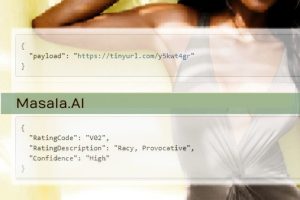
Media Rating API - FAQ
Back in 2009, during the boom of smartphones and high-speed internet, the founders faced a new problem – user generated content. Internet pornography has always been a challenge and traditional filters called blacklists existed to solve this problem, although not fully effective. But user generated content posed a new set of challenges. Typical manifestations of this and other associated developments were a) Teenagers sharing nude selfies succumbing to peer pressure b) Mis-use and distribution of such user generated content by parties not connected with the user c) Children being lured by internet predators through new techniques d) New social networks and file sharing applications that bypass traditional filters
One way to address this ever growing challenge was to deal with the problem at source, which is to have computers analyze such content and make a determination automatically to block content. The original paper that addressed this problem can be found here vRate white paper. The first version of the API addressed this unique problem quite effectively and was available to select audiences. The latest version now applies the state-of-the-art in artificial intelligence and deep learning and is available to wider audiences. You can now use this API to recognize and moderate images containing explicit nudity, as well as images with much more subtler obscene content that are typically hard to catch. A fine-grained rating mechanism also helps distinguish images that do not have explicit nudity, but at the same time are considered provocative or racy because the subjects in the image expose too much skin, wear revealing clothing or pose provocatively.
The API applies several computer vision algorithms directly on the image to extract features that identify with nudity. Several neural networks including the latest deep learning implementations are then leveraged to determine the final rating. All of these run-on high-end computing resources complemented with scalable serverless endpoints to provide you with a rating in a matter of seconds. Finally, the methods that we apply are constantly evolving as technology advances, so accuracies can only improve from here.
Generally, the accuracy of such a service depends on a variety of conditions ranging from the quality of the image, the foreground/background objects etc. The algorithm is designed to work under a variety of situations, contexts and background scenes. Our tests have revealed an accuracy ranging from 86% to 96% depending on the above factors.
Our algorithms have been tuned to be biased towards features that identify with nudity. This means that the sensitivity of the algorithm towards nudity is high and thus the probability of correctly identifying an image with nudity is very high. However, this also impacts the false positive rate which in our current tests have revealed to be between 5% to 10% depending on various factors. A demo is available on the website to help your carry out your own tests. if you have custom requirements, please contact us.
The API is simple and effortless to integrate, Please read Getting Started, and the API documentation with code samples here.
The API can be leveraged to detect nudity and pornography, recognize obscenity in images, including detection of subjects with skimpy, revealing clothing which would typically be considered as racy or provocative. Inappropriate content is an issue not just for families with young children, but also in educational environments, public places, business environments among others. Inadvertent display of such content could lead to loss of reputation and trust, non-compliance with policies and guidelines, blackmail and even legal expenses. This API could be used to moderate images that users upload to websites, smartphone apps, social networks, to screen online survey/competition submissions, moderate ads or mitigate the impact of internet trolls.
We do not store your images on our servers, each image is typical processed by our routines in memory and temporary copies if any are destroyed once the rating is determined. All processing occurs on servers based in the US. If your legal requirements necessitate the need for a private or regional server in your country, please reach out to us.
We support all major formats & sizes – JPG, PNG, BMP & TIF. If support for GIF images is required, please reach out to us.
Yes, do reach us through the contact form. We deal with use cases where there is a need for sub-second response with thousands of concurrent requests.
Sure, we have a batch process that can operate on images locally and this would require you to send us the images over sFTP.
We can scale up to larger volumes through custom configurations of our serverless offerings or by provisioning dedicated GPUs for heavier workloads. Please reach out to us so we can setup a private plan for you.
A video analysis API is in development but if you can’t wait, do reach us through the contact form and we can provision a custom solution for you. Our Video API can also work on streaming media to perform real time content analysis.
Our algorithms apply several optimizations, and techniques that minimize the use of computing resources, while taking advance of scalable serverless architecture for some of our offerings. Consequently, we are able to offer several more transactions per computing unit. We pass this benefit to our customers.
Artificial intelligence (AI) has become mainstream. With the recent advances in deep learning and the availability of high performance computing at lower costs, we believe AI will become all the more pervasive. While we are not near yet to comparable human accuracy, certain types of tasks that reduce massive human effort and monitoring can be automated.
Recent Posts
Recent Comments
Archives
Categories
- Adversarial Machine Learning
- AIOps
- AWS
- AWS Lambda
- Convolutional Neural Networks
- Crowd Counting
- Data Science
- Deep Learning
- Deep Recurrent Neural Networks
- Deep Reinforcement Learning
- GAN
- Gated Recurrent Unit
- Long Short-Term Memory
- Machine Learning
- Medium
- Medium-Archive
- Nudity Detection
- RNN
- VRate Archive
- Whitepaper